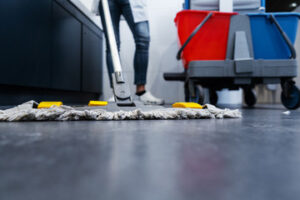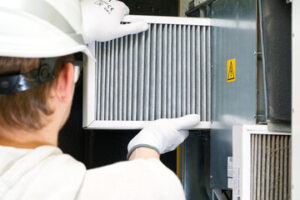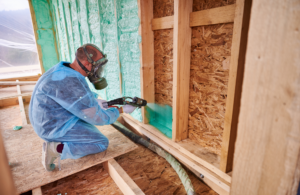Commercial Cleaning Baltimore focuses on cleaning and maintaining workplaces. This includes trash removal, sanitization, and cleaning shared equipment like doorknobs and light switches.

A commercial cleaning company will also take note of problem areas in the building, such as stains on carpets or water marks on windows. They will then report these issues to the appropriate person to fix them quickly.
Commercial cleaning services offer a variety of different services, from deep cleaning and waste removal to sanitizing restrooms and emptying trash bins. These services can be tailored to meet the needs of any business, including retail stores, restaurants, offices, and hospitals. A clean environment can help businesses attract customers and keep them happy by improving health and safety, increasing productivity, and making a good first impression.
Commercial cleaners can also be used to perform larger cleaning jobs, such as graffiti removal and window washing. These tasks require specialized equipment and training, which many commercial cleaning companies have. They can also save businesses money by performing these services more efficiently than in-house staff can.
Some companies offer additional ad hoc cleaning services, such as disaster cleanup and asbestos removal. This may include cleaning up after fires, floods, and accidents in addition to regular maintenance cleaning. Other ad hoc cleaning services can include washing exterior windows and doors, scrubbing sidewalks and entranceways, vacuuming carpeting, and washing and disinfecting shared furniture.
Office cleaning services are a vital part of any business. They involve cleaning common areas, private cubicles, restrooms, and kitchens. Tasks can include mopping floors, dusting furniture and fixtures, removing garbage, and sanitizing door handles and light switches. Cleaning services can also provide other janitorial services, such as emptying trash cans, scrubbing and waxing floors, and cleaning glass surfaces.
Upholstery cleaning is another important service offered by commercial cleaning services. It removes dirt, allergens, and stains from upholstery, which can improve indoor air quality and reduce respiratory problems for employees and patrons. It is usually done with water or solvents, depending on the fabric.
The bathrooms in any business are vital for promoting good hygiene and giving customers and visitors a positive impression. Cleaning services can sanitize the sinks, toilets, and countertops, remove odors, and wipe all surfaces. They can also restock supplies, wipe mirrors and windows, and sweep and mop the floors.
Cleaning services can also perform larger cleaning projects, such as stripping and waxing vinyl and linoleum floors, buffing and burnishing tile and concrete, and deep cleaning hardwood and porous flooring. They can also perform floor scrubbing and finishing, which involves using high-pressure cleaning to remove scuff marks.
Waste Removal and Recycling
Commercial cleaners have to be familiar with a variety of sanitation rules and regulations. They need to know how to properly dispose of items like florescent bulbs, electronics, batteries, and automotive waste. Moreover, they should understand how to recycle items like yard trimmings, food waste, and paper products. This will help them save on landfill fees and ensure that they follow local recycling rules.
Some commercial cleaning services also offer waste removal and recycling services. For instance, they might have a composting program where they convert organic material into soil amendment. This will improve the condition of the soil, which in turn will protect the environment. It can also be a great way to reduce the cost of fertilizer for local farmers.
Another service that many commercial cleaners offer is sanitisation. Sanitisation is a vital process that kills viruses and germs, and it is especially important in places like restrooms and kitchens. Moreover, it can prevent the spread of disease and make employees and customers feel safe in the workplace. In addition to that, sanitisation can also keep enclosed spaces from smelling musty.
Most commercial cleaning companies have rates that are calculated by the square footage of a space. These rate structures are often used because they are easier to manage than individual hourly rates. In addition, they can help the company keep track of its costs and revenues.
In order to be successful, a commercial cleaning company needs to provide excellent customer service. They need to be friendly and attentive to their clients, as well as flexible in terms of scheduling. This is because some businesses have unique requirements that may change from week to week. For example, a client might request that certain surfaces be wiped down or that an extra trash bag be placed in the bin.
Another aspect of customer service that a commercial cleaning company must pay attention to is keeping up with the latest technologies and cleaning tools. This will ensure that they remain competitive and can attract new business. It can also ensure that they have the resources they need to keep up with the ever-changing needs of their clients. For example, a cleaning service might invest in high-powered vacuums that can remove stains from carpets and tile.
Cleaning Equipment
Commercial cleaning services use a range of professional-grade, specialized equipment to clean and disinfect establishments. They can offer one-time and recurring cleaning service, depending on a business’s needs. This can include a variety of machines such as sweepers, scrubbers and carpet cleaners. A wide range of chemicals are also used, including disinfectants and sanitizers. Unlike home cleaning supplies, which can be purchased at any store, these chemicals are often more powerful and require special training to use safely.
The scope of work for a commercial cleaning company will vary depending on the facility, but general cleaning tasks may include cleaning and sanitizing countertops, walls, floors, tables, desks, chairs, and computer keyboards. They might also clean and replenish soap dispensers, paper towels, and toilet tissue in restrooms. Other common tasks include dusting and high-dusting, which may involve ladders or lifts. Some businesses may require additional or deeper cleaning, such as a movie theater that has sticky floors from soda and butter popcorn.
A commercial cleaning service will also use a variety of janitorial supplies to clean surfaces and large areas, including mops, brooms, buckets, sponges, squeegees, and brushes. These cleaning supplies can be used to apply and remove cleaning products to a variety of surfaces, including windows. Door handle tissues can provide a shield against germs when touching doors and handles, while facial tissues are soft for more delicate cleaning.
A professional commercial cleaning service can be an invaluable asset for any business. They can save a business money on cleaning supplies, cleaning and labor costs, and employee sick days. They can also improve a business’s image and increase productivity by providing a clean and safe environment for employees and customers. If you are interested in hiring a commercial cleaning service, contact us today to discuss your needs and to see how we can help. We carry top-of-the-line Tennant industrial cleaning equipment that includes power sweepers, scrubbers and carpet cleaners for a complete cleaning solution. Learn more about our equipment and request a quote today!
Training
The cleanliness of a business is important, especially for businesses that handle raw materials or personal spaces. Uncleanliness can lead to pests, health hazards and safety risks. For this reason, cleaning services often work with professional training programs to ensure that their staff can perform their jobs properly and quickly. These trainings can be conducted on-the-job, in classrooms or through online courses and certifications.
Cleaning services may also work to obtain industry-specific certificates and recognitions that prove their quality of service. This can help them gain client trust and increase their chances of winning contracts. For example, a commercial cleaning company can seek Green Seal certification to show that they follow environmental standards. They can also pursue Global Biorisk Advisory Council (GBAC) accreditation to demonstrate that they follow best practices for cleaning, disinfecting and preventing the spread of infectious diseases.
In addition to industry-specific qualifications, commercial cleaning services can seek to gain customer service training. This can include learning how to handle complaints, defuse confrontations and take ownership of a job. This training can be provided on-the-job or through online courses and certifications, such as EdApp’s Customer Service Training for Janitorial Custodial Professionals course.
While many cleaning services focus on the inside of a facility, it is important to make sure that the outside of a building is clean as well. This is because the exterior of a building can be seen by clients, which can affect their perception of a company’s cleanliness and professionalism. For this reason, many cleaning services will seek to obtain a certification for outdoor cleaning.
One such certificate is ISSA’s Cleaning Management System (CMS) certification, which teaches cleaning professionals how to run their business. This certification provides proof that a cleaning business follows best practices and has the tools to keep its clients happy and satisfied. In addition, it demonstrates that a cleaning business can meet the specific needs of each client. In order to receive this certificate, a cleaning business must complete a series of assignments and tests. The course lasts for six weeks and includes access to a faculty member to provide teaching assistance and answer questions.








